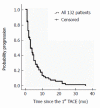Oxaliplatin and 5-fluorouracil hepatic infusion with lipiodolized chemoembolization in large hepatocellular carcinoma
- PMID: 25852283
- PMCID: PMC4385545
- DOI: 10.3748/wjg.v21.i13.3970
Oxaliplatin and 5-fluorouracil hepatic infusion with lipiodolized chemoembolization in large hepatocellular carcinoma
Abstract
Aim: To investigate transarterial chemoembolization (TACE) with hepatic infusion of oxaliplatin and 5-fluorouracil and Lipiodol chemoembolization in large hepatocellular carcinoma (HCC).
Methods: In this retrospective study, 132 patients with unresectable HCCs larger than 10 cm were treated with hepatic infusion of oxaliplatin and 5-fluorouracil followed by Lipiodol chemoembolization. The primary endpoint was overall survival (OS). Sixteen-week disease-control rate, time to progression (TTP), and major complications were also studied. Univariate and multivariate analyses were performed to identify prognostic factors affecting OS and TTP.
Results: A total of 319 procedures were performed in the 132 patients. Eleven (8.3%) patients received radical resection following TACE treatment (median time to initial TACE 4.3 ± 2.3 mo). The median OS and TTP were 10.3 and 3.0 mo respectively, with a 50.0% 16-wk disease-control rate. Major complications were encountered in 6.0% (8/132) of patients following TACE and included serious jaundice in 1.5% (2/132) patients, aleukia in 1.5% (2/132), and hepatic failure in 3.0% (4/132). One patient died within one month due to serious hepatic failure and severe sepsis after receiving the second TACE. The risk factor associated with TTP was baseline alpha-fetoprotein level, and vascular invasion was an independent factor related to OS.
Conclusion: Hepatic infusion of oxaliplatin and 5-fluorouracil followed by lipiodolized-chemoembolization is a safe and promising treatment for patients with HCCs larger than 10 cm in diameter.
Keywords: 5-fluorouracil; Hepatic infusion; Large hepatocellular carcinoma; Oxaliplatin; Transarterial chemoembolization.
Figures


Similar articles
-
Hepatic Arterial Infusion of Oxaliplatin, Fluorouracil, and Leucovorin Versus Transarterial Chemoembolization for Large Hepatocellular Carcinoma: A Randomized Phase III Trial.J Clin Oncol. 2022 Jan 10;40(2):150-160. doi: 10.1200/JCO.21.00608. Epub 2021 Oct 14. J Clin Oncol. 2022. PMID: 34648352 Clinical Trial.
-
Hepatic artery infusion chemotherapy using mFOLFOX versus transarterial chemoembolization for massive unresectable hepatocellular carcinoma: a prospective non-randomized study.Chin J Cancer. 2017 Oct 23;36(1):83. doi: 10.1186/s40880-017-0251-2. Chin J Cancer. 2017. PMID: 29061175 Free PMC article. Clinical Trial.
-
Chemoembolization alone vs combined chemoembolization and hepatic arterial infusion chemotherapy in inoperable hepatocellular carcinoma patients.World J Gastroenterol. 2015 Sep 28;21(36):10443-52. doi: 10.3748/wjg.v21.i36.10443. World J Gastroenterol. 2015. PMID: 26420971 Free PMC article. Clinical Trial.
-
Significant efficacy and well safety of apatinib in an advanced liver cancer patient: a case report and literature review.Oncotarget. 2017 Mar 21;8(12):20510-20515. doi: 10.18632/oncotarget.14724. Oncotarget. 2017. PMID: 28103584 Free PMC article. Review.
-
Superselective Conventional Transarterial Chemoembolization for Hepatocellular Carcinoma: Rationale, Technique, and Outcome.J Vasc Interv Radiol. 2016 Sep;27(9):1269-1278. doi: 10.1016/j.jvir.2016.04.014. Epub 2016 Jun 24. J Vasc Interv Radiol. 2016. PMID: 27345337 Review.
Cited by
-
5-Fluorouracil combined with CalliSphere drug-eluting beads or conventional transarterial chemoembolization for unresectable hepatocellular carcinoma: a propensity score weighting analysis.Sci Rep. 2024 Oct 26;14(1):25588. doi: 10.1038/s41598-024-77531-2. Sci Rep. 2024. PMID: 39462077 Free PMC article.
-
Aspirin in combination with TACE in treatment of unresectable HCC: a matched-pairs analysis.Am J Cancer Res. 2016 Sep 1;6(9):2109-2116. eCollection 2016. Am J Cancer Res. 2016. PMID: 27725915 Free PMC article.
-
The effect of radiotherapy in liver-confined but non-resectable Barcelona Clinic Liver Cancer stage C large hepatocellular carcinoma.Oncotarget. 2016 Sep 20;7(38):62715-62725. doi: 10.18632/oncotarget.10908. Oncotarget. 2016. PMID: 27486881 Free PMC article.
-
Development and Validation of a Nomogram for Patients Undergoing Transarterial Chemoembolization for Recurrent Hepatocellular Carcinoma After Hepatectomy.J Hepatocell Carcinoma. 2024 Apr 4;11:693-705. doi: 10.2147/JHC.S444682. eCollection 2024. J Hepatocell Carcinoma. 2024. PMID: 38596594 Free PMC article.
-
Caffeine enhances the anti-tumor effect of 5-fluorouracil via increasing the production of reactive oxygen species in hepatocellular carcinoma.Med Oncol. 2019 Oct 29;36(12):97. doi: 10.1007/s12032-019-1323-8. Med Oncol. 2019. PMID: 31664534
References
-
- Jemal A, Bray F, Center MM, Ferlay J, Ward E, Forman D. Global cancer statistics. CA Cancer J Clin. 2011;61:69–90. - PubMed
-
- Takayasu K. Transcatheter arterial chemoembolization for unresectable hepatocellular carcinoma: recent progression and perspective. Oncology. 2013;84 Suppl 1:28–33. - PubMed
-
- Llovet JM. Updated treatment approach to hepatocellular carcinoma. J Gastroenterol. 2005;40:225–235. - PubMed
-
- Oliveri RS, Wetterslev J, Gluud C. Transarterial (chemo)embolisation for unresectable hepatocellular carcinoma. Cochrane Database Syst Rev. 2011;(3):CD004787. - PubMed
MeSH terms
Substances
LinkOut - more resources
Full Text Sources
Other Literature Sources
Medical
Miscellaneous

